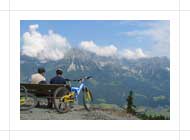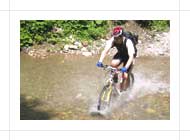 Mountain Biking Safety Tips
Mountain Biking Safety Tips
guide to safe mountain biking
Interested in safe mountain biking? Whether mountain biking alone, with your mates or with a Professional Guide on holiday, it is always important to remember the basics that will keep your cycling both fun and safe. The follow points might come across as really obvious, however, it is normally by ignoring or forgetting one of these simple facts that a great day's cycling turns into a bit of a nightmare. So in no particular order, here are our suggestions for you.
1. put that helmet on your head
It might be hot and sweaty, it might itch on the straps but that helmet is the second most important thing to protect you whilst you're riding your bike. Funnily enough, its job is to protect the single most important thing whilst out on the trail - your brain! Make sure the helmet that you buy fits comfortably on your head (an inch above your eyebrows) and doesn't slip forwards or backwards. One commonly forgotten adjustment is the side straps, make sure that they are pulled upwards and tighten just below the ear. Also, the chin strap needs to be tight enough, without suffocating you, or too far forward. If you have a double chin then nicely nestled under there is perfect. Before heading off, talk to your mates, you should feel the helmet pull down a bit when your mouth is open - otherwise it is too loose. return to top
2. all the gear ... no idea
Just like most walks of life you can glamorise and accessorize to your heart's content. However, when you get through all the marketing hype what is important is that you can get back on your bike the next day, and the day after, without too many creaks and groans. It is really down to the climate and the type of mountain biking that you are doing. Are you mountain biking up forest paths in the midday sun or doing ten foot drop offs in the rain? Are you prone to fall off a lot or is steady pace enough for you? Anything that keeps your mind firmly on the mountain biking and off nicks, scratches and cuts makes for safer mountain biking.
So first, gloves, full or cut offs, take your pick. Protect your hands a bit from knocks, falls and blisters. Next, shoes, are you racing? wearing clips? Most importantly make sure the laces are well tucked in so they don't get caught up with the chainset. MTB clothing, get some padded shorts, baggies or erm, lycra if you have to. Any protection for your rear is a good thing in my opinion! Depending on your location and riding there is body armour, padding and shin protection to see you safely down a mountain. Again, obvious, but important, make sure the gear is the right size and you're wearing it properly. If it slips off or twists on impact then you are minimising its use. Make sure you are carrying / wearing plenty of layers of clothes. As a minimum have a cycling top and a waterproof available. Better still, carry another layer just in case the weather changes quickly whilst you are out mountain biking. Finally, wear some protective glasses they will protect you from the sun, small debris that might flick up and branches across the trails. return to top
3. know your fitness
It is good to push yourself but know your body. If, when you go for a ride you ache a bit the next day - not a problem. If you are unable to ride for the next three days then you've probably pushed yourself too far. The most important safety issue with fitness and your body is letting others know how you are feeling. Let your fellow riders know if you've taken a knock, are feeling weak or light headed or would simply like to stop for a bit. Don't be too proud!!! Easy to say, hard to do. The consequences of trying to 'carry on' can be pretty severe. For example, sun stroke is extremely dangerous and can hit you surprisingly quickly. Finally, make sure you've taken on board plenty of water and have some high energy snacks available.
Of all the safety points that are made here, understanding your body and letting others know how you feel ensures that everyone can enjoy their mountain biking trips together. return to top
4. know where you are and where you're going
Basic scouts stuff this. Let someone know where you are going and when you will be back. Obviously make sure it isn't someone that's going to be on the ride with you!! Plan exit routes as well, so if there are problems at any of the stages of your trip, you are able to confidently decide the quickest and safest way to services that you need. Whether they are first aid, bike parts or beer.
Unless it is a route that you've ridden many times, take a map, compass and / or GPS unit. If the weather changes, things can look very different in the fog or rain. Have your mobile with you as well and make sure that batteries are charged and that you have spares. Know which numbers you might need out on the route e.g. ambulance, mountain rescue or a friend who is able to pick you up. Plan your routes with plenty of time left over before nightfall just in case you have bike problems or you go a little off route. return to top
5. think about your riding
Pushing yourself and learning new skills is one of the most enjoyable parts of mountain biking. Don't get caught in a rut or stay in your comfort zone too long. What we mean by 'think about your riding', is choose carefully when to take risks. If you have never done a drop off then don't try your first one when your legs are tired and wobbly at the end of a days mountain biking. Know what the consequences are at every stage of your ride. Breaking a collar bone ten miles from the nearest accessible road, was it really worth the bravado? Remember that when you are riding in a group, your risks have an impact on the rest of the group. If you think a section is well beyond your skill level then get off your bike, take a look and only ride it if you are confident that you can complete it with the minimal amount of risk to yourself and others.
Remember - ride within your own abilities, it is your responsibility to the group and yourself. return to top
6. basic first aid
Mountain bikers aren't expected to be elite paramedics, however, basic first aid that can be learnt in half an hour can save lives. Grab an up to date book from the library or offer to be a first aider at work. Know if any of your group have health problems or aren't feeling one hundred percent before you head out riding. Sunburn, cuts and bruises and general fatigue can all be handled with a little common sense. However, a basic knowledge of treating breaks, sun stroke, concussion and shock are all extremely useful on the trails. return to top
- If your kids like mountain biking, they might also like adventure camps.
- When mountain biking, accidents can sometimes occur. Give this bicycle accident lawyer a call, and see if you are entitled to compensation.
- This personal injury lawyer in Vancouver can help you when you have a bike accident in British Columbia.
7. a safe bike
If your mountain bike is well maintained then you will be safer on the trails. So, how do you make sure that everything is running as it should be. Firstly, this isn't a comprehensive maintenance guide just a few pointers to help to try and keep you out of trouble. If you aren't sure how to repair things then take it to your local bike shop. Better to be safe than sorry.
So, grab your mountain bike and systematically check it from front to back. First the brakes, lift each wheel in turn and apply pressure to the brake lever, they should never touch the handle bars. Common problems are brake cable stretched, pads are worn, brakes knocked out of alignment with rims or discs. Next, tyres, check the pressure, use a pump gauge to check if the pressure is high enough - too low and you're more likely to get flats. You'll learn from experience whether you like your tires harder or softer. Remember all tires lose air over time.
The mechanics, when riding on tough, challenging routes your gears and other parts might get bashed a bit. There are fine adjustments that can be made to ensure smooth gear transitions. Get to learn your bike, understand when / which gears get you in trouble, if you can't fix any problems yourself, pop down to the local bike shop.
If you ride gently and click through all the gears you'll soon realise when / where the problem occurs by listening and feeling for awkward noises and movements. Diagnosing where the problem is, is half the battle, it is then a case of asking yourself, does it need replacing, tightening, re-aligning or lubing.
Just like cars, mountain bikes require oil and it's the chain that takes a lot of the wear, regularly applying oil to the chain will help extend the life of the chain and chainset. More importantly for safety on the trails, it will help prevent the chain breaking or locking the wheels. Even though your dad says that WD40 is great for everything, unfortunately it's not the case for mountain bikes. Ask at your local bike shop which oil is best for your area.
Headsets, brakes, cassettes, bottom bracket, chainsets, front gear mechs, rear gear mechs, pedals, saddles can all take knocks, check for loose parts, clean and tighten.
Performing all these checks, either when you get back from a mountain bike ride or before you go out for the next one will help protect you and your bike for when you go out and give it another good beating! return to top


 Digg
Digg Delicious
Delicious reddit
reddit Facebook
Facebook Google
Google Stumbleupon
Stumbleupon


